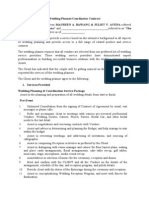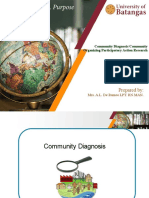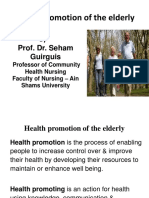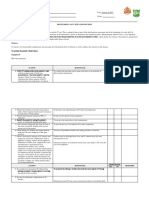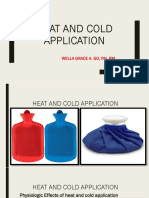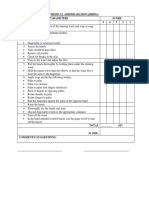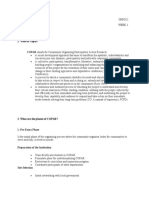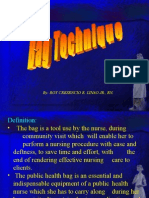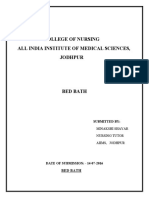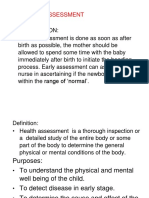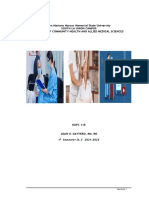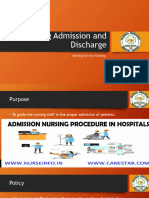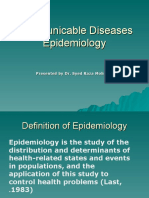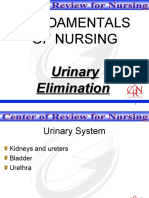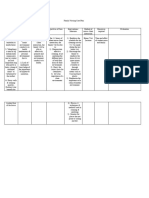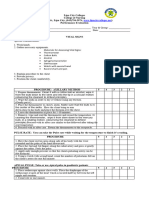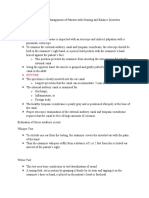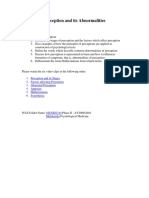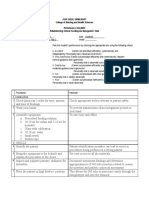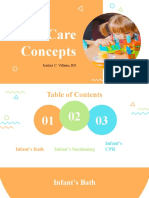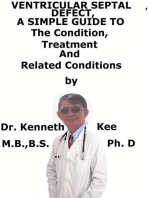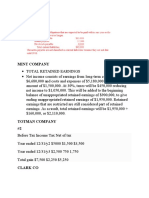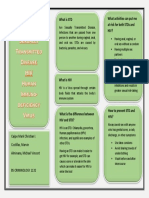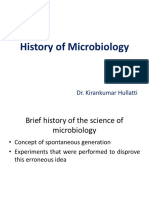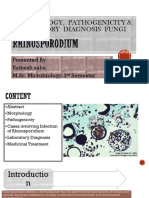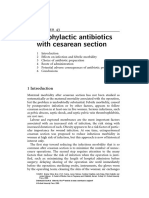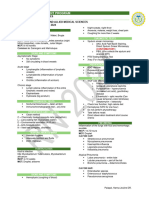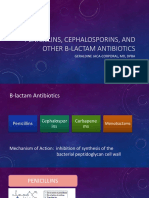Principles, Contents, and Steps: Clinical Instructor
Uploaded by
Willie KitsPrinciples, Contents, and Steps: Clinical Instructor
Uploaded by
Willie KitsPrinciples, Contents, and Steps
Belen G. Delos Trinos
Clinical Instructor
The Bag Technique
The bag technique is a tool by which the nurse,
during her visit will enable her to perform a nursing procedure with ease and deftness, to save time and effort with the end view of rendering effective nursing care to clients.
The Public Health Bag
The public health bag is an essential and
indispensable equipment of a public health nurse which she has to carry along during her home visits. It contains basic medication and articles which are necessary for giving care.
Principles of bag technique
1. Performing the bag technique will minimize, if not totally prevent the spread of any infection. 2. It saves time and effort in the performance of nursing procedures. 3. The bag technique should show the effectiveness of total care given to an individual or family. 4. The bag technique can be performed in a variety of ways depending on the agencys policy, the
home situation, or as long as principles of avoiding transfer of infection is always observed.
Important points to consider in the use of the bag
1. The bag should contain all the necessary articles, supplies and equipments that will be used to answer the emergency needs
2. The bag and its contents should be cleaned very often, the supplies replaced, and ready for use anytime.
Important points to consider in the use of the bag (cont)
3. The bag and its contents should be well protected from contact with any article in the patients home. Consider the bag and its contents clean and sterile, while articles that belong to the patients as dirty and contaminated.
4. The arrangement of the contents of the bag should be the one most convenient to the user, to facilitate efficiency and avoid confusion.
Contents of the public health bag
Arranged from bottom to top:
Sterile gloves 2. Clean white apron in plastic bag (an extra apron to replace the first after attending a morbid case) 3. Sterile instruments
1.
2 kelly forceps (straight/curved) 1 mayo scissors Thumb or tissue forceps
Contents of the public health bag (cont)
4. Bandage pack (all in plastic bag) top dressing (4x4 gauze pad) cotton balls cotton tip applicators cord ties or clamps tongue depressors plaster (micropore) bandage scissors syringes/needles 5. Kidney basin placed upside down 6. Clean white apron in plastic bag
Contents of the public health bag (cont)
5. Hand towel - white 6. Towel lining - white 7. Paper lining
Inner pocket (from left to right) 1. Liquid soap 2. Alcohol 70% 3. Ophthalmic ointment 4. Sulfosalysylic acid 10% or acetic acid 5. Benedicts solution 6. Lysol 7. Betadine
Contents of the public health bag (cont)
Front pocket
1.
2.
Cornocopia Small paper lining Digital thermometer Weighing scale Tape measure
Left pocket
1.
2.
3.
Right pocket
1. 2. 3. 4.
Test tubes - 2 Test tube holder Medicine dropper Alcohol lamp
Contents of the public health bag (cont)
Top cover of the bag: clip paper with
1. 2.
Names of families to be visited (prioritize case to be visited, clean case first) Addresses
Inside cover flap
1.
2.
Family records( HBMR, GROWTH CHART, Forms ( Birth Certificate
NOTE: When walking, hold the bag with the opening towards the body. To facilitate opening of the bag.
Steps in Performing the Bag Technique Action
ACTIONS RATIONALE
1. Introduces self to the client and states the purpose of the visit. 2. Holds the bag with the non-dominant hand and retrieves the paper lining from the bag using the dominant hand.
To gain trust and cooperation.
Provides ease in retrieving the paper lining while holding the bag. The paper lining provides a clean work field.
Steps in Performing the Bag Technique Action
ACTIONS RATIONALE
3. Sets the paper lining on a The side of the lining that table or any flat surface with the touches the table is clean side out (outer folds considered contaminated. touching the surface/table) using the dominant hand. 4. Positions the bag on top of the paper lining while securing the bags handles or strap beneath the bag. Protects the bag from contamination. Keeping the straps of the bag out of the way will facilitate ease in retrieving materials from the bag.
Steps in Performing the Bag Technique Action
ACTIONS RATIONALE
5. Obtains and sets-up a basin of water (when faucet is not available) outside the working area.
To be used for handwashing. To protect the work field from being wet.
6. Opens the bag, retrieves the To make a non-contaminated towel lining and spreads it over work-field area. the working area, clean side out (outer folds touching the table/surface and inner folds up).
Steps in Performing the Bag Technique Action
ACTIONS RATIONALE
7. Retrieves the hand towel, In preparation for hand soap and apron from the bag washing. and places them at one corner within the confines of the paper lining.
8. Leaves towel and soap wrappers inside the bag.
To prevent crosscontamination.
Steps in Performing the Bag Technique Action
ACTIONS RATIONALE
9. Performs proper hand washing. 10. Dries hands with the hand towel.
To prevent spread of microorganisms.
11. Puts the hand towel and Readily accessible for use soap back in the same corner of after performing a procedure. the working area.
Steps in Performing the Bag Technique Action
ACTIONS RATIONALE
12. Dons the apron right side out sliding the head into the neck strap then neatly tying the apron strap at the back.
To protect the nurses uniform.
13. Retrieves materials needed To make them readily for the specific case from the accessible while performing a bag (e.g. thermometer, cotton procedure. balls, paper bag) and sets these items at the working area within the confines of the towel lining.
Steps in Performing the Bag Technique Action
ACTIONS RATIONALE
14. Places the waste disposal bag outside the working area.
To prevent contamination of clean area.
15. Closes the bag.
To prevent contamination of bag and its contents.
16. Performs the specific nursing care or treatment.
To give comfort and security, maintain personal hygiene and hasten recovery.
Steps in Performing the Bag Technique Action
ACTIONS RATIONALE
17. When care or treatment is completed, cleans and alcoholizes materials used.
To protect caregiver and prevent spread of infection to others.
18. Performs proper hand washing.
To prevent spread of microorganisms.
Steps in Performing the Bag Technique Action
ACTIONS RATIONALE
19. Dries hands with hand Aftercare towel, places the towel and soap back at the same corner of the working area. 20. Opens the bag and returns To maintain orderliness in the the materials in the bag, bag. properly arranging these in their respective designated places.
Steps in Performing the Bag Technique Action
ACTIONS RATIONALE
21. Folds the hand towel (soiled side folded inwards). 22. Places the hand towel and soap inside the bag. 23. Folds the towel lining (soiled side folded inwards).
Prevents contamination of other contents of the bag.
Prevents contamination of the other contents of the bag.
Steps in Performing the Bag Technique Action
ACTIONS RATIONALE
24. Returns the towel lining in the bag.
25. Removes apron folding it Prevents contamination and away from the body (soiled side spread of microorganisms. folded inwards).
26. Places the apron inside the bag.
Steps in Performing the Bag Technique Action
ACTIONS RATIONALE
27. Closes the bag. 28. Carries the bag on the nondominant arm.
29. Folds the paper lining (clean side folded inwards) using the dominant hand.
Steps in Performing the Bag Technique Action
ACTIONS RATIONALE
30. Inserts the paper lining in the bag flap. 31. Provides the client with information relevant to health care and schedules the next appointment (home or clinic) noting the date, time and purpose of the next visit.
Aftercare. Used as reference for future visits. For follow-up and continuity of care.
Evaluation and documentation 1. Record all relevant findings about the client and members of the family. 2. Take note of environmental factors which affect the clients/family health. 3. Include quality of nurse-client relationship. 4. Assess effectiveness of nursing care provided.
You might also like
- Prepared By:: Community Diagnosis/Community Organizing Participatory Action ResearchNo ratings yetPrepared By:: Community Diagnosis/Community Organizing Participatory Action Research41 pages
- Assessment NSG Diagnosis Goal Intervention Implementation EvaluationNo ratings yetAssessment NSG Diagnosis Goal Intervention Implementation Evaluation2 pages
- Monitoring An Intravenous Infusion - Ancog, JNo ratings yetMonitoring An Intravenous Infusion - Ancog, J5 pages
- Heat and Cold Application: Wella Grace A. Go, RN, RMNo ratings yetHeat and Cold Application: Wella Grace A. Go, RN, RM24 pages
- Medical Asepsis (Handwashing) Parameters Score 5 4 3 2 1No ratings yetMedical Asepsis (Handwashing) Parameters Score 5 4 3 2 136 pages
- Assessing Mental Status and Substance AbuseNo ratings yetAssessing Mental Status and Substance Abuse48 pages
- What Is Copar?: COPAR Stands For Community Organizing Participatory Action ResearchNo ratings yetWhat Is Copar?: COPAR Stands For Community Organizing Participatory Action Research4 pages
- NCM 313 Healthcare Ethics Other Relevant Ethical PrinciplesNo ratings yetNCM 313 Healthcare Ethics Other Relevant Ethical Principles2 pages
- Legaspi - Preparing Medication From A Vial ChecklistNo ratings yetLegaspi - Preparing Medication From A Vial Checklist4 pages
- College of Nursing All India Institute of Medical Sciences, JodhpurNo ratings yetCollege of Nursing All India Institute of Medical Sciences, Jodhpur14 pages
- Bed Bath Procedure: Presented By: Prof - Vijayreddy Vandali Dept of Medical-Surgical Nursing IndiaNo ratings yetBed Bath Procedure: Presented By: Prof - Vijayreddy Vandali Dept of Medical-Surgical Nursing India17 pages
- Fundamentals of Nursing: Urinary EliminationNo ratings yetFundamentals of Nursing: Urinary Elimination26 pages
- Checklist On Vital Signs - Blood Oxygenation Using Pulse OxymeterNo ratings yetChecklist On Vital Signs - Blood Oxygenation Using Pulse Oxymeter2 pages
- Levels of Care: Submitted By: Juliene Hannah V. FloresNo ratings yetLevels of Care: Submitted By: Juliene Hannah V. Flores94 pages
- Assessment of Nose, Sinuses, Mouth and Throat-JCCNo ratings yetAssessment of Nose, Sinuses, Mouth and Throat-JCC43 pages
- FNCP Family Nursing Care Plan 1 Poor Environmental Sanitation Health ThreatNo ratings yetFNCP Family Nursing Care Plan 1 Poor Environmental Sanitation Health Threat2 pages
- Adventist University of The Philippines: Urinary Cathetirization P RIS RemarksNo ratings yetAdventist University of The Philippines: Urinary Cathetirization P RIS Remarks2 pages
- NCM 116 Alterations in Nutri and GI Rev5No ratings yetNCM 116 Alterations in Nutri and GI Rev5100 pages
- Assessment and Management of Patients With Hearing and Balance Disorders100% (1)Assessment and Management of Patients With Hearing and Balance Disorders9 pages
- Infant Care Concepts: Jessica C. Villano, RNNo ratings yetInfant Care Concepts: Jessica C. Villano, RN38 pages
- CBT - Nutrition and Digestive System Edited100% (1)CBT - Nutrition and Digestive System Edited22 pages
- International Nursing Council Presentation of Group 1No ratings yetInternational Nursing Council Presentation of Group 138 pages
- Ventricular Septal Defect, A Simple Guide To The Condition, Treatment And Related ConditionsFrom EverandVentricular Septal Defect, A Simple Guide To The Condition, Treatment And Related ConditionsNo ratings yet
- High Functioning CPR Bringing Science To The Pit Crew FINAL 3-1-13No ratings yetHigh Functioning CPR Bringing Science To The Pit Crew FINAL 3-1-1368 pages
- What Is STD What Activities Can Put Me at Risk For Both Stds and Hiv?No ratings yetWhat Is STD What Activities Can Put Me at Risk For Both Stds and Hiv?1 page
- Coronavirus Fun Activities Games - 122497No ratings yetCoronavirus Fun Activities Games - 1224975 pages
- Case studies in immunology a clinical companion common variable immunodeficiency 5th ed Edition Geha - Download the full ebook now for a seamless reading experience100% (1)Case studies in immunology a clinical companion common variable immunodeficiency 5th ed Edition Geha - Download the full ebook now for a seamless reading experience47 pages
- Keith Edwards Score For Diagnosis of Tuberculosis. IJP.03No ratings yetKeith Edwards Score For Diagnosis of Tuberculosis. IJP.033 pages
- NUR 342 Unit Ii: Management of Patients With Structural, Infectious, and Inflammatory Cardiac Disorders100% (1)NUR 342 Unit Ii: Management of Patients With Structural, Infectious, and Inflammatory Cardiac Disorders49 pages
- UPPER RESPIRATORY TRACT INFECTIONS Practice QuizNo ratings yetUPPER RESPIRATORY TRACT INFECTIONS Practice Quiz4 pages
- 10 Biology Model Qns (Eng Med) All Units - Rasheed OdakkalNo ratings yet10 Biology Model Qns (Eng Med) All Units - Rasheed Odakkal14 pages
- Pencillins, Cephalosporins and Other B-Lactam AntibioticsNo ratings yetPencillins, Cephalosporins and Other B-Lactam Antibiotics45 pages
- Prepared By:: Community Diagnosis/Community Organizing Participatory Action ResearchPrepared By:: Community Diagnosis/Community Organizing Participatory Action Research
- Assessment NSG Diagnosis Goal Intervention Implementation EvaluationAssessment NSG Diagnosis Goal Intervention Implementation Evaluation
- Heat and Cold Application: Wella Grace A. Go, RN, RMHeat and Cold Application: Wella Grace A. Go, RN, RM
- Medical Asepsis (Handwashing) Parameters Score 5 4 3 2 1Medical Asepsis (Handwashing) Parameters Score 5 4 3 2 1
- What Is Copar?: COPAR Stands For Community Organizing Participatory Action ResearchWhat Is Copar?: COPAR Stands For Community Organizing Participatory Action Research
- NCM 313 Healthcare Ethics Other Relevant Ethical PrinciplesNCM 313 Healthcare Ethics Other Relevant Ethical Principles
- Legaspi - Preparing Medication From A Vial ChecklistLegaspi - Preparing Medication From A Vial Checklist
- College of Nursing All India Institute of Medical Sciences, JodhpurCollege of Nursing All India Institute of Medical Sciences, Jodhpur
- Bed Bath Procedure: Presented By: Prof - Vijayreddy Vandali Dept of Medical-Surgical Nursing IndiaBed Bath Procedure: Presented By: Prof - Vijayreddy Vandali Dept of Medical-Surgical Nursing India
- Checklist On Vital Signs - Blood Oxygenation Using Pulse OxymeterChecklist On Vital Signs - Blood Oxygenation Using Pulse Oxymeter
- Levels of Care: Submitted By: Juliene Hannah V. FloresLevels of Care: Submitted By: Juliene Hannah V. Flores
- FNCP Family Nursing Care Plan 1 Poor Environmental Sanitation Health ThreatFNCP Family Nursing Care Plan 1 Poor Environmental Sanitation Health Threat
- Adventist University of The Philippines: Urinary Cathetirization P RIS RemarksAdventist University of The Philippines: Urinary Cathetirization P RIS Remarks
- Assessment and Management of Patients With Hearing and Balance DisordersAssessment and Management of Patients With Hearing and Balance Disorders
- International Nursing Council Presentation of Group 1International Nursing Council Presentation of Group 1
- Ventricular Septal Defect, A Simple Guide To The Condition, Treatment And Related ConditionsFrom EverandVentricular Septal Defect, A Simple Guide To The Condition, Treatment And Related Conditions
- High Functioning CPR Bringing Science To The Pit Crew FINAL 3-1-13High Functioning CPR Bringing Science To The Pit Crew FINAL 3-1-13
- What Is STD What Activities Can Put Me at Risk For Both Stds and Hiv?What Is STD What Activities Can Put Me at Risk For Both Stds and Hiv?
- Case studies in immunology a clinical companion common variable immunodeficiency 5th ed Edition Geha - Download the full ebook now for a seamless reading experienceCase studies in immunology a clinical companion common variable immunodeficiency 5th ed Edition Geha - Download the full ebook now for a seamless reading experience
- Keith Edwards Score For Diagnosis of Tuberculosis. IJP.03Keith Edwards Score For Diagnosis of Tuberculosis. IJP.03
- NUR 342 Unit Ii: Management of Patients With Structural, Infectious, and Inflammatory Cardiac DisordersNUR 342 Unit Ii: Management of Patients With Structural, Infectious, and Inflammatory Cardiac Disorders
- 10 Biology Model Qns (Eng Med) All Units - Rasheed Odakkal10 Biology Model Qns (Eng Med) All Units - Rasheed Odakkal
- Pencillins, Cephalosporins and Other B-Lactam AntibioticsPencillins, Cephalosporins and Other B-Lactam Antibiotics
